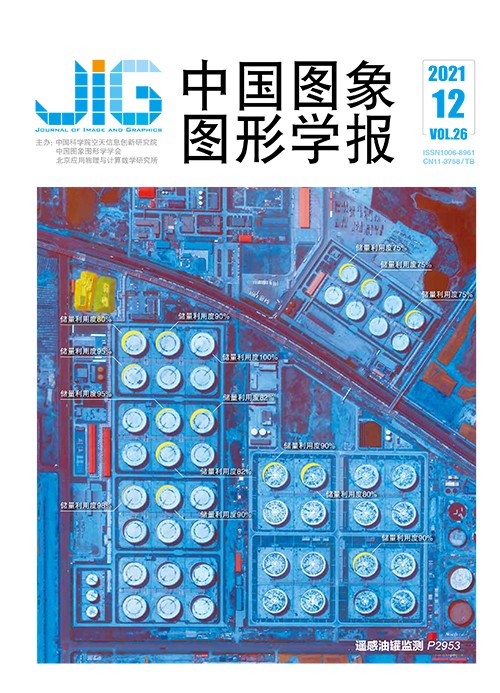
遥感图像中油罐目标精确定位与参数提取
江晗1,2,3, 张月婷1,2, 郭嘉逸1, 赵鑫1,2,3, 李芳芳1, 黄丽佳1, 胡玉新1, 雷斌1, 丁赤飚1(1.中国科学院空天信息创新研究院, 北京 100194;2.中国科学院空天信息创新研究院空间信息处理与应用系统技术重点实验室, 北京 100190;3.中国科学院大学电子电气与通信工程学院, 北京 100049) 摘 要
目的 浮动顶油罐是遥感图像中具有圆形特征的典型人造目标,其高精度定位与参数提取问题是一类代表性的应用问题,针对该问题,传统的基于圆形特征的变换域提取方法鲁棒性差,参数选择需要不断手动调整;基于深度学习的方法利用对已有标注图像的训练求解网络参数,提高了自动化程度,但对于圆形目标而言,覆盖圆周需要较大的感受野,这对应较大的网络结构,随之带来细节信息缺失或参数量、运算量增大的问题。本文针对油罐的定位与参数提取问题,将传统特征提取与深度学习结合,提出了一种计算量小、精度高的方法。方法 基于快速径向对称变换(fast radial symmetry transform,FRST)后的变换域数据及原始数据构建了卷积神经网络(convolutional neural networks,CNN),给出了训练过程及参数选择,有效地将圆形特征的先验引入深度学习过程,计算复杂度低,用较少层的网络实现了高精度的定位。结果 基于SkySat数据的实验表明,该方法比单纯基于深度学习的方法在相同网络量级上精度得到了有效提高,预测误差平均降低了17.42%,且随着网络深度的增加,精度仍有明显提高,在较浅层次网络中,预测误差平均降低了19.19%,在较深层次网络中,预测误差平均降低了15.66%。结论 本文针对油罐遥感图像定位与参数提取问题,提出了一种基于变换域特征结合深度学习的方法,有效降低了计算量,提升了精度和稳定性。本文方法适用于油罐等圆形或类圆形目标的精确定位和参数提取。
关键词
Accurate localization and parameter extraction of oil tank in remote sensing images
Jiang Han1,2,3, Zhang Yueting1,2, Guo Jiayi1, Zhao Xin1,2,3, Li Fangfang1, Huang Lijia1, Hu Yuxin1, Lei Bin1, Ding Chibiao1(1.Aerospace Information Research Institute, Chinese Academy of Sciences, Beijing 100194, China;2.Key Laboratory of Technology in Geo-Spatial Information Processing and Application Systems, Aerospace Information Research Institute, Chinese Academy of Sciences, Beijing 100190, China;3.School of Electronic, Electrical and Communication Engineering, University of Chinese Academy of Sciences, Beijing 100049, China) Abstract
Objective Object localization and parameter extraction have been one of the vital applications for remote sensing image interpretation and the basis of information extraction nowadays. The acquired accuracy is the key factor to improve the accuracy of information inversion. As a typical man-made object with circle shape in remote sensing image, the high-precision localization and parameter extraction of floating roof oil tank have been the representative application issues. The elevation of the top cover of the floating roof oil tank has been fluctuated up and down with the change of oil storage volume. The remote sensing image of the oil tank has presented different circle shadows and multiple circle areas in terms of the elevation change. The localization and parameter extraction analysis of the oil tank has referred to the measurement of the center position of the tank roof, the center position of the circular-arc-shaped shadow cast has projected by the sunshine on the floating roof and the radius of the oil tank image, which is of great significance for the inversion of the oil tank structure and the oil storage information. However, the distribution and overlapping characteristics of circles in oil tank images have related to many factors, such as illumination, cloud cover, satellite observation and imaging conditions, background environment, side wall occlusion and so on. Therefore, for localization and parameter extraction of floating roof oil tank, it is necessary to develop a localization and parameter extraction method to adapt with circle shaped objects. The traditional parameterized feature extraction method has included Hough transform and template matching. The emerging deep learning method has been developed recently. Traditional parameterized feature extraction method can make effective use of the circumference feature with the non-learnable and the poor applicability of parameters. The lower automation has relied on priori knowledge to adjust parameters manually. The method based on deep learning has its advantages to use the training of the existing labeled images to solve the parameters of the network, which improves the degree of automation. For objects with circular structure, convolutional neural networks (CNNs) can predict the radius and get accurate location of the circle center. The disadvantages have been described as follows:First, the main feature of an object with circular structure such as oil tank is on the circumference, but not in the circle. The neural networks need to traverse all the pixels, which leads to redundant computation and a low processing efficiency. Next, CNN has increased the receptive field and aggregated the spatial features via cascading networks subject to the receptive field. At last, abundant training samples requirement has not existed in traditional parameterized feature extraction method. This research has proposed a method of low calculation and high precision by combining the traditional feature extraction method with deep learning to resolve the problem of localization and parameter extraction of oil tank in remote sensing images, which no longer needs to sacrifice resolution or increase the network. Method A CNN has been constructed via fast radial symmetry transform (FRST). The training process and parameter has been sorted out. The image is processed by FRST and the original image and the processed image are superimposed as two channels of the image into a new dual channel image, which is input into the designed CNN for processing. The result has been compared with the result of the single channel original image into the same CNN for processing. The experiment is based on a self-made dataset of SkySat satellite data, compared under two CNN architectures, and ran once under two fixed random seeds. This method has illustrated the priori knowledge of circular feature into the deep learning process effectively. Low-computational complexity has been presented. High-precision localization based on relatively few layers of network has been realized. Result The experimental results have shown that the accuracy of the proposed method is effectively improved at the same network level and the average prediction error is reduced by 17.42%. Moreover, the prediction error has been decreased by 19.19% on average in the shallower network. In the deeper network, the prediction error has been deducted by 15.66% on average. Conclusion This research has demonstrated the transform domain features combined with deep learning to improve the accuracy of the localization and parameter extraction of oil tank in remote sensing images effectively.
Keywords
remote sensing image oil tank localization parameter extraction deep learning fast radial symmetry transform(FRST)
|



 中国图象图形学报 │ 京ICP备05080539号-4 │ 本系统由
中国图象图形学报 │ 京ICP备05080539号-4 │ 本系统由